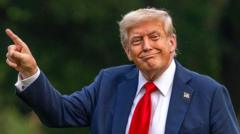The trade agreement reached between the United States and Japan has garnered attention as it could be one of the most impactful trade deals in recent history, according to US President Donald Trump. Although it may still be early to label it as the largest, it stands out as the most substantial accord since Trump's implementation of so-called Liberation Day tariffs in April, which destabilized markets and disrupted global trade flows. The anticipated positive effects of the deal are being eyed by Japan's Prime Minister Shigeru Ishiba, who asserts it could bolster the global economy. But what does this mean for the broader economic landscape?
Japan, as the world's fourth-largest economy, holds a crucial place in international trade and commerce. It imports a significant quantity of energy and food while being heavily reliant on exports such as electronics, machinery, and automotive products. The US serves as Japan's most significant export destination. Concerned experts had anticipated the implications of climbing tariffs that could potentially lead Japan into recession, deterring economic growth by impacting exports.
The new trade deal involves lowered tariffs for exporters, which could result in cheaper trade conditions with the US. This move has resulted in the Japanese yen gaining strength against the US dollar, thereby granting Japanese manufacturers more leeway in sourcing raw materials necessary for production increases. Key beneficiaries of this agreement include automotive giants Toyota, Nissan, and Honda, who stand to gain from reduced tariffs on vehicle exports to the US—dropped from 27.5% to 15%. However, US automakers express dissatisfaction, facing higher tariffs on imports from Canada and Mexico compared to Japan’s more favorable rates.
In exchange for the tariff reductions, Japan has pledged to invest $550 billion in the US, a commitment aimed at establishing robust supply chains in crucial sectors, including pharmaceuticals and semiconductors. This investment is expected to create job opportunities and enhance innovation and product quality in the US marketplace. Moreover, Japan has committed to escalating the purchase of American agricultural products, such as rice, which could alleviate local shortages while potentially concerning domestic farmers about market competition.
The agreement also sets the stage for competitive negotiations among other Asian countries, such as South Korea and Taiwan, who may be looking to secure similar favorable terms with the US before the impending August deadline. However, smaller Asian economies, like Cambodia and Laos, might struggle to attract US attention given their limited trade leverage. There remains speculation about defense spending, despite clarifications from Tokyo stating that such matters do not form part of this trade deal. Meanwhile, steel and aluminum tariffs stay confirmed, highlighting Japan's export focus on vehicles over these materials.
On the same day the US and Japan made their announcement, Japan also emphasized collaboration with Europe to create a united front against economic coercion and unfair trade practices, establishing further complexities regarding US-EU trade relations. This multifaceted trade environment challenges countries to seek stable partnerships while navigating fluctuating diplomatic tides.
The US-Japan trade agreement thus emerges as a pivotal point of analysis for economists and policymakers, shaping not only the bilateral relationship but potentially realigning trade practices across the globe.
Japan, as the world's fourth-largest economy, holds a crucial place in international trade and commerce. It imports a significant quantity of energy and food while being heavily reliant on exports such as electronics, machinery, and automotive products. The US serves as Japan's most significant export destination. Concerned experts had anticipated the implications of climbing tariffs that could potentially lead Japan into recession, deterring economic growth by impacting exports.
The new trade deal involves lowered tariffs for exporters, which could result in cheaper trade conditions with the US. This move has resulted in the Japanese yen gaining strength against the US dollar, thereby granting Japanese manufacturers more leeway in sourcing raw materials necessary for production increases. Key beneficiaries of this agreement include automotive giants Toyota, Nissan, and Honda, who stand to gain from reduced tariffs on vehicle exports to the US—dropped from 27.5% to 15%. However, US automakers express dissatisfaction, facing higher tariffs on imports from Canada and Mexico compared to Japan’s more favorable rates.
In exchange for the tariff reductions, Japan has pledged to invest $550 billion in the US, a commitment aimed at establishing robust supply chains in crucial sectors, including pharmaceuticals and semiconductors. This investment is expected to create job opportunities and enhance innovation and product quality in the US marketplace. Moreover, Japan has committed to escalating the purchase of American agricultural products, such as rice, which could alleviate local shortages while potentially concerning domestic farmers about market competition.
The agreement also sets the stage for competitive negotiations among other Asian countries, such as South Korea and Taiwan, who may be looking to secure similar favorable terms with the US before the impending August deadline. However, smaller Asian economies, like Cambodia and Laos, might struggle to attract US attention given their limited trade leverage. There remains speculation about defense spending, despite clarifications from Tokyo stating that such matters do not form part of this trade deal. Meanwhile, steel and aluminum tariffs stay confirmed, highlighting Japan's export focus on vehicles over these materials.
On the same day the US and Japan made their announcement, Japan also emphasized collaboration with Europe to create a united front against economic coercion and unfair trade practices, establishing further complexities regarding US-EU trade relations. This multifaceted trade environment challenges countries to seek stable partnerships while navigating fluctuating diplomatic tides.
The US-Japan trade agreement thus emerges as a pivotal point of analysis for economists and policymakers, shaping not only the bilateral relationship but potentially realigning trade practices across the globe.





















